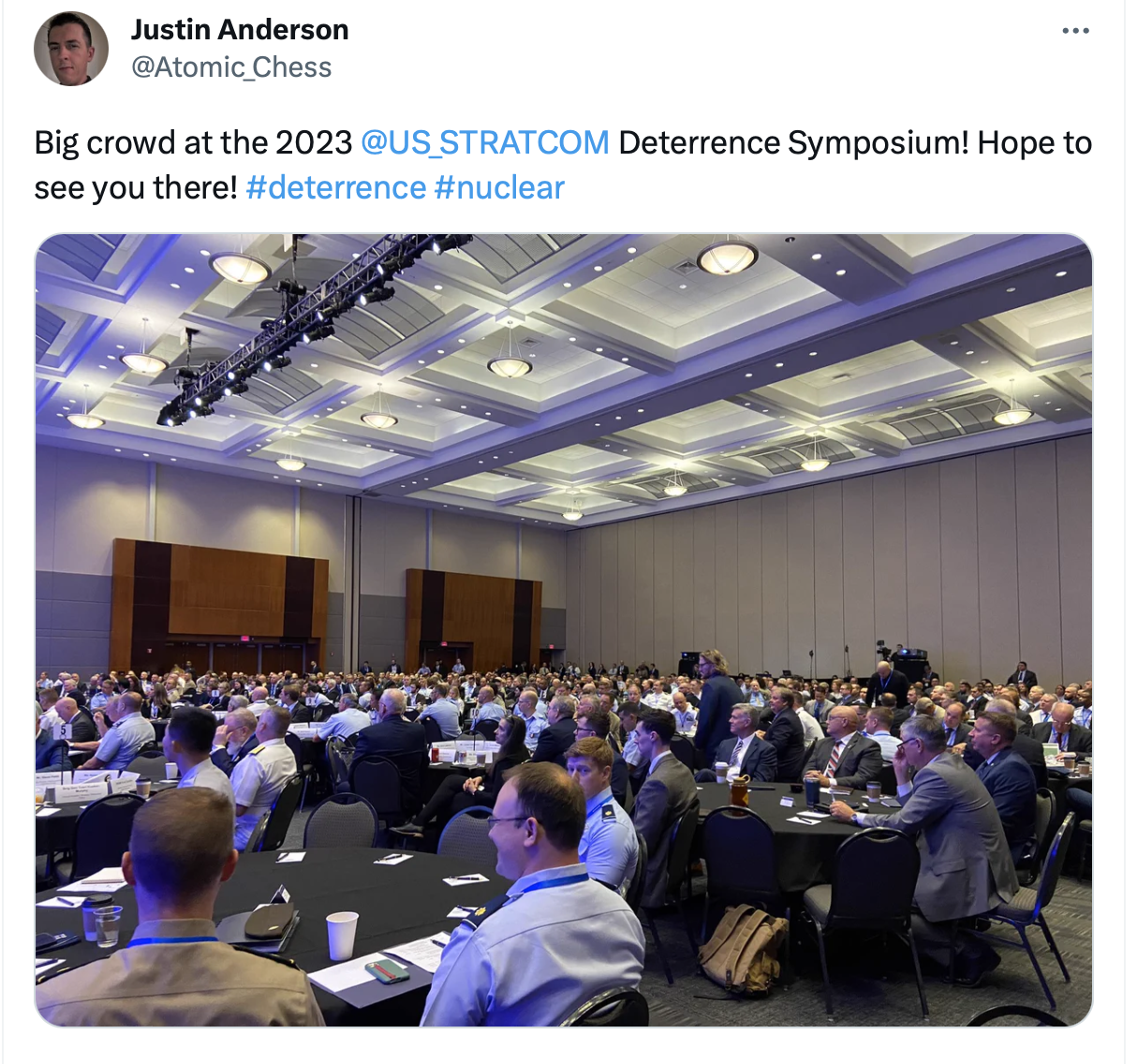Carol Cohn is the G.O.A.T. Back in 1987, she wrote what is still the best gendered take on the pathologies of deterrence in a piece called, “Sex and Death in the Rational World of Defense Intellectuals.”
It absolutely demolishes the cult of the missile bro. And every deterrence scholar I know who’s not a caveman kneels before this article with overt praise. Many swear they even teach it.
Yet, modern deterrence theory is basically all rationalist—an implicit rejection of Cohn’s critique. The language of the field—from “Minuteman missiles” to “vertical erector launchers”—remains unbelievably phallic. And while that article has 2,081 citations in Google Scholar as of now (which speaks to its fame), most of those cites are not from deterrence scholars. In fact, I know of few deterrence scholars who even account for her critique—or consider a feminist perspective generally—in their work.
What are we supposed to make of that? It seems that Carol Cohn is to the deterrence community as kente cloth is to Nancy Pelosi amid the Movement for Black Lives: symbolic deference as an alternative to material redress.
The community’s failure to take Cohn’s critique of rational deterrence—and defense intellectualism—seriously has left a dangerous legacy.
I was reminded of all this when I saw that US Strategic Command (USSTRATCOM)—in charge of the nukes—just hosted a big “deterrence” symposium. It’s an annual thing. Years ago, as part of another life, I may have attended it (I did multiple USSTRATCOM engagements back in the day but I don’t recall precisely what they were).
What I didn’t notice then, but couldn’t help but notice now, was just how old, white, and male it is. I mean look at that sea of sameness.
Bruh. Only five of the 36 speakers were women. I assume there were about that many (or fewer) ethnic minorities too.
Now, I’m a cis-hetero dude. I’m half white. And as an elder millennial, I probably qualify as an “old.” Which is only to say that 1) I should choose my words carefully, and 2) I’m not trying to vilify the old white dudes—they have a place in this world too…they just shouldn’t get to dictate to everyone else.
But I’m also not crowing about diversity for the sake of it. There’s a thesis in a photo like that. If that picture were black and white, I’d swear it was from the 1950s.
What it makes me think is this: The in-group homogeneity of the social network whose vocation is fingering the nuclear button creates and reifies ideological conformity about coercion and national security strategy.
Put differently, the world of nuclear strategy is full of bros of a certain age, and the nuke-bro way of thinking is hard to dislodge because there’s such a high percentage of nuke bros. Consequently, we’re stuck making choices that don’t just make the world dangerous for the rest of us, but also that—ironically—erode our own power over time.
Magical Deterrence Thinking
US nuclear strategy—and USSTRATCOM in particular—consists of some of the most dangerous, antiquated, and largely unchallenged ideas in foreign policy, including that the US must:
- Retain both nuclear superiority and a nuclear triad.
- Spend $1.7 trillion over 30 years modernizing this unmatchable force.
- Spend tens of billions on ballistic missile defenses to complement the ability to out-nuke any adversary.
- Promise to use nuclear weapons on behalf of certain US allies (NATO, Japan, and South Korea).
- Occasionally forward-deploy its nuclear weapons to ensure adversaries believe the United States is serious about nuking others.
- And at all costs let others think that the United States might be the first to use nukes in a crisis or conflict. Washington cannot pledge “no-first use.”
In the world of the Wizards of Armageddon—where I used to make my living—these all represent largely unassailable positions. They are thought of as prerequisites for deterrence, without which the world will annihilate itself. Oh sweet irony.
I find these positions mostly unreasonable, and certainly worthy of being questioned. But among the people with proximity to power, I know of no evidence that anybody questions them.
To the contrary, these nuke guys are the Brahmin class of “great-power competition” scare mongering. By fetishizing deterrence, they come up with intricate technocratic arguments to justify a hypermilitarized status quo. In service of these beliefs, they are ever-vigilant for “gaps”—missile gaps, ship gaps, battlefield-nuke gaps. Even balloon gaps! For USSTRATCOM, deterrence itself is a “gap” that needs filling.
Worshipping at the altar of Thomas Schelling (as I too was trained to do) can have that effect on you. For the gap-obsessed, the world is a zero-sum game where the real measure of success is to dictate and not be dictated to; the accumulation of power to be lorded over others.
That’s not just domination by any other name; that’s an absurdly reductive way of looking at a complex world. As C. Wright Mills reasoned:
Coercion, in the last resort, is the ‘final’ form of power, but of course we are by no means constantly at the last resort.
And with due respect to Schelling, his way of seeing erases the concerns and costs imposed on populations of people forced to eat the price of rational bargaining games.
The oppressed have no place in models of “resolve,” except maybe as tools for signalling to adversaries.
The question is why. Why are such dangerous ideas treated as common sense among a certain cohort?
After all, there are plenty of critics of the “rational deterrence mind,” as most of the 2,081 citations of Carol Cohn attest. But those critics tend not to work on deterrence research. Neither are they in vocations that utilize concepts of deterrence or impact foreign policy choices. And they sure as hell don’t get invited to USSTRATCOM’s deterrence symposium.
This is why that striking photo is suggestive. Perhaps nonsense becomes common sense when monocultures make thinking differently impossible, or at least impractical. When everyone’s a good-ole-boy, change is bound to be difficult.
Regrettably, I was less aware of diversity as an issue when I worked on deterrence strategy in government. In spite of that, I remember how stifling the vibe of those meeting rooms were. Nobody wanted to appear weak or naive. There was pressure to go along to get along. Everybody was status conscious—and the people with the highest status usually happened to be old white dudes (again, no shade). And most of all, nobody wanted to take political or diplomatic risks (ironic for a vocation that venerates threat-making).
The cult of deterrence could be described as such precisely because of how much consensus there is, but that high degree of consensus surely owes something to the cult’s identity homogeneity.
Inclusion Without the Diversity Trap
There’s a bit of a trap waiting in the space where (un)diversity meets national security.
Making the ruling class 10% blacker will not fix the problems that flow from a society exploited by a ruling class. Making the national security state—which is by definition the most secretive and unaccountable set of institutions in any democracy—more female is no kind of political horizon on its own.
To fix problems that we associate with a lack of diversity, distributions of power must change. The content of foreign policy must change to account for those most harmed by it. It is not enough to change the faces of who hides government decisions from the public or who drones bad guys without due process. A rainbow trillion-dollar war machine is still a trillion-dollar war machine.
But changing faces is also not a bad starting point. Where in-group homogeneity prevails, decision-making pathologies abound. And at the risk of poking the “anti-woke” crowd, there’s something to be said for “queering” the national security state.
Seeing things from a different standpoint helps us to perceive contradictions, put seemingly narrow choices in a wider context, and more accurately assess the costs and risks of strategy. We will provide for the national interest more faithfully when our institutions reflect the diversity of our society. And that means racial and gender diversity, yes, but also class diversity and ideological diversity.
There should be little doubt that US national security policy has become a very wasteful enterprise. For indicators of that we can look at the opportunity cost of defense spending, the blowback incurred when the world reacts adversely to US choices, and the damage democracy itself suffers by waging “all measures short of war” against foreign foes.
That we can persist in the same ways powered by the same problematic ideas may be because we insist on having the same kinds of people stewarding our national phallus weapons. Continuing this way, as I’ve written before, is a path to ruin.
Patriarchy—like all forms of domination—is the author of its own demise. By operating in the world in ways that take security from others in order to provide security for yourself, you inspire future generations to rise up against you.
Maybe that’s why the most terrified, paranoid, aggrieved people in modern society are not its biggest victims but its biggest beneficiaries.
This is a cross-posting at the Un-Diplomatic newsletter.



0 Comments